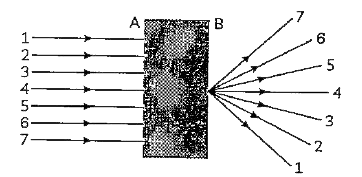Lenses made of transparent materials such as glass or plastic with curved surfaces. Diverging lenses are thicker at their edges than at their centres and make light rays passing through them spread out. Converging lenses are thicker in middle than at edges and make light rays passing through them focus at a point.
Abhishek uses two lenses I and II of same size and same material as shown P1 and P2 are the powers of A and B. An object is kept at the same distance from the lenses between Fand 2F of each lens on the principal axis in turn Let li and la be the image formed by two lenses respectively. Which one of the following statements is correct for the images formed?

A
Distance or image l2 will be less than distance or image l1 from the lens
B
Size or image l1 will be equal to size or image l2
C
Distance of image l2 will be be greter than distnace or image l1 iron the lens
D
Size of image l1 will be tesser than size or image l2
Text Solution
The correct Answer is:A
Because thicker has less focal length than thinner lens.
|
Similar Questions
Knowledge Check
Lenses made of transparent materials such as glass or plastic with curved surfaces. Diverging lenses are thicker at their edges than at their centres and make light rays passing through them spread out. Converging lenses are thicker in middle than at edges and make light rays passing through them focus at a point.
For lenses I and IIAP1=P2BP1<P2CP1>P2DP1 is positive and P2 is negativeLenses made of transparent materials such as glass or plastic with curved surfaces. Diverging lenses are thicker at their edges than at their centres and make light rays passing through them spread out. Converging lenses are thicker in middle than at edges and make light rays passing through them focus at a point.
A beam of light is incident on the box through the holes on side A and emerges out of the holes on the side B of the box:

Which of the following is present the boxAConcave lensBRectangular glass plateCprismDConvex lensLenses made of transparent materials such as glass or plastic with curved surfaces. Diverging lenses are thicker at their edges than at their centres and make light rays passing through them spread out. Converging lenses are thicker in middle than at edges and make light rays passing through them focus at a point.
Sakshi conducts an experiment to produce an image of an object on a screen which is placed at 20 cm from the lens. She uses a convex lens of focal length 15 cm produce the sharpest image?A20 cm in front of the lensB8 cm in front of the lensC15 cm in front of the lensD60 cm in front of the lens
Which of the following lenses will bend the light rays through largest angle?
View SolutionWhich type of lenses are:
a) Thinner in the middle than at the edges?
b) thicker in the middle than at the edges?
View SolutionLook at the shapes of lenses and answer the questions:

Which three of these lenses are converging lenses?
View SolutionConvergent beam of light is passed through a diverging lens. Light rays after passing lens
View SolutionWhich of the following cannot be used for making lenses ?
View Solution
